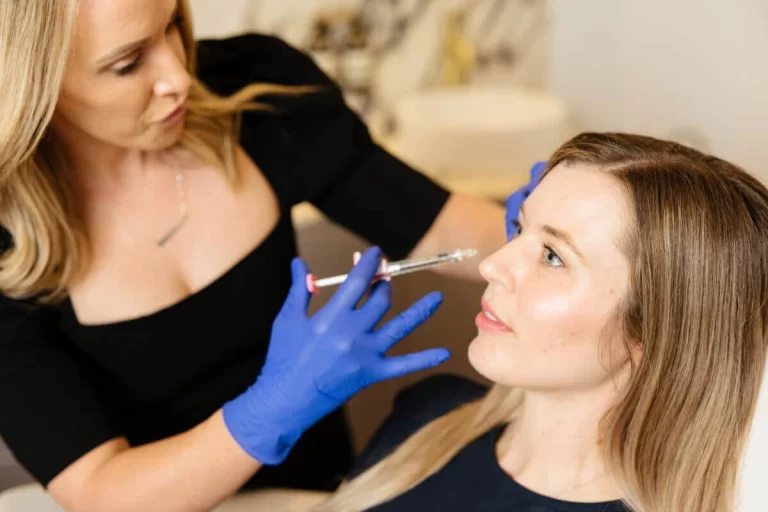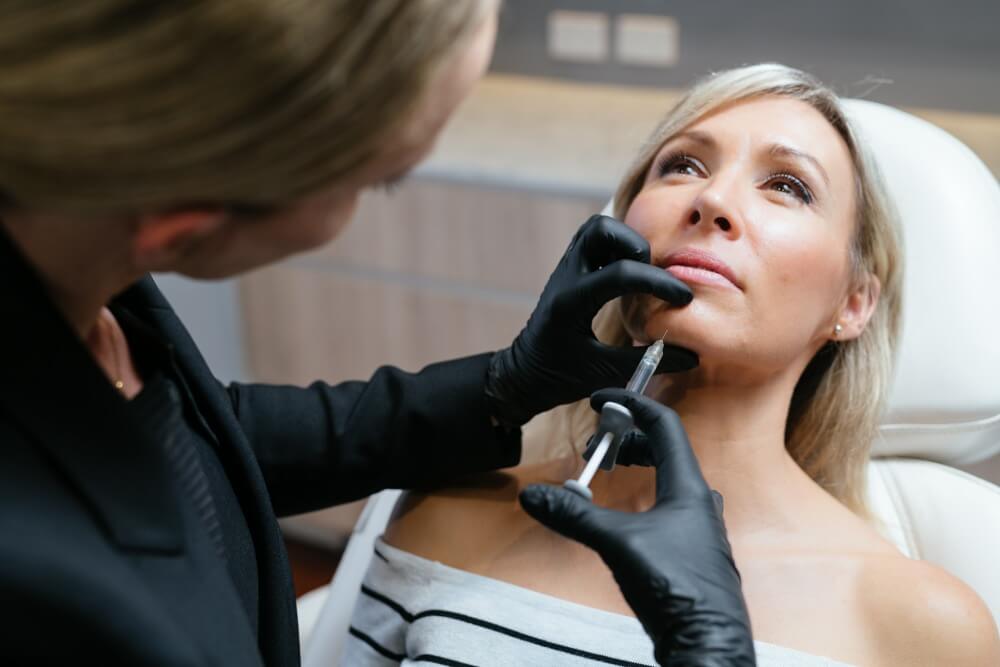Dissolving Dermal Filler FAQs

Here at Youth Lab, we specialise in performing corrective and revision treatment for clients who may have had complications elsewhere.
One of the most common corrective treatments we see and perform is dissolving dermal fillers either due to adverse events (complications occurring at the time or immediately after treatment) or due to poor aesthetic outcomes.
Today I want to talk about dissolving dermal fillers due to unsatisfactory cosmetic results, or “botched” dermal fillers. We see a lot of clients who have had treatments in the past with poorly placed dermal filler, migration of filler to other areas of the face, hard and lumpy fillers or fillers that simply look wrong and unbalanced.
Often dissolving and correcting previous treatments is necessary prior to having further treatment done. Yes, it is unfair and many want to have their next treatment done as soon as possible, but in 99.99999% of cases; being patient, having the filler corrected and then retreated delivers the best outcome.
Unfortunately, cosmetic medical and surgical procedures still carry risks and often adverse events can occur. This post is in NO way saying that other clinics or practitioners do not perform treatments to the best of their ability, I have certainly had my fair share of complications in my years of practice. However, due to no adequate regulation in the cosmetic medical industry, there are providers offering procedures for which they are not sufficiently trained, nor insured to perform. As such, this has resulted in a rise in ‘botched’ treatments and an increase in adverse events.
We love correcting dermal fillers here at Youth Lab and find it one of the most satisfying treatments to perform.
So without further ado, here is a list of the most common questions I get about this process.

Why would I dissolve my dermal filler?
We use a dissolving agent to dissolve dermal filler in the following circumstances:
- Vascular compromise in an emergency situation (this is not the focus of this blog)
- The Tyndall effect where due to the scattering of light, there is a bluish hue to the skin. It is often caused by injecting too superficially, placing large volumes of product in one area or using an inappropriate product for the area treated. It is most commonly seen in the tear trough area.
- Overcorrection or misplacement of dermal filler, resulting in a poor cosmetic appearance
- Migration of dermal filler, especially in the lips. We are seeing so many more cases of this as popular injection techniques (such as the Russian Lip) which do not take into account the delicate anatomy of the lip. This then creates channels that cause the filler to spread above the lip.
- Lumps or nodules that may appear several months after the initial treatment may be amenable to dissolving.
Can all dermal fillers be dissolved?
Not all dermal fillers can be dissolved. The dissolving agent used can only dissolve temporary fillers made of a naturally occurring substance. These fillers are the most popular and widely used. These are the fillers used to augment cheeks and lips most commonly.
Other fillers which are semi-permanent, such as those marketed as collagen stimulators cannot be reversed or corrected in this way.
What is used to dissolve the fillers?
The agent used is called Hyaluronidase, or Hyalase. This is an enzyme which breaks down hyaluronic acid into smaller polysaccharide chains. It is extremely effective in removing excess exogenous hyaluronic acid.
The dose required is dependent on several factors relating to the particular dermal filler, whether it is particulate or non-particulate, the amount of cross-linking and the concentration of the filler.
Will it dissolve my natural Hyaluronic Acid?
This is a common concern about the dissolving process and one that often needs clarifying. Hyaluronidase may degrade the body’s natural hyaluronic acid in preference to foreign hyaluronic acid that has been injected. HOWEVER, our natural hyaluronic acid has a half-life of about 24 hours in the skin meaning it replenishes every day. Any natural hyaluronic acid that may be dissolved in the treatment area will return to normal very quickly.
It is also important to note that natural hyaluronic acid does not volumise the skin, it is a hydrator so most clients simply note some transient dehydration.
Are there risks?
Dissolving dermal fillers with Hyalase is an off label procedure and must be performed in a medical setting.
In some cases we will advise a skin patch test to be performed prior to the procedure in case of an allergic reaction. However, the risk is exceptionally rare. In those who have an anaphylactic reaction (not just an allergy) to bee stings, there may be a cross-reaction with Hyalase causing anaphylaxis. This will be discussed at your consultation prior to treatment and should be part of the informed consent prior to any dermal filler treatment regardless.
Often clients will experience swelling (more severe than with the initial filler treatment) which can be quite confronting.
Does it hurt?
Most clients are fearful of the pain of dissolving and have heard from friends and family who may have had this done that it hurts much more than the original treatment.
Hyalase can sting significantly on injection, however at Youth Lab, we use anaesthetic mixed with the Hyalase to remove any sting from the injection. Occasionally, a topical anaesthetic may be used if multiple injections are required, but the majority of clients feel that the treatment is comfortable.
What is the recovery like?
The recovery from dissolving dermal fillers is often short and manageable. There is initial swelling which in certain areas such as the lips and under eyes can be significant and last for 24 to 48 hours. Once the swelling subsides, the loss of volume from the dermal filler dissolving will be evident (most note an immediate improvement with the dermal filler breaking down immediately).
In some areas, where large volumes of dermal filler are dissolved, there may be residual skin laxity. This is normal and often preferable to puffy and misplaced filler.
Other common post-injection recovery includes expected redness, swelling, pain, itching, bruising and tenderness at the injection site. They have generally been described as mild to moderate and typically resolve spontaneously a few days after injection. Bruising may occasionally be more significant than with dermal filler treatment.
How many treatments do I need?
It is important for clients to note that the corrective and revision process may take time with multiple treatments required.
For certain types of dermal fillers (brand names cannot be mentioned), more sessions may be needed due to the way the molecules in the filler are cross-linked. The previous volume of dermal filler injected, as well as how long the filler has been present can also impact the success of treatment. Larger volumes of filler injected years ago may need 3 to 4 sessions of dissolving before full resolution. I often perform these at two weekly intervals.
In most cases though, we obtain a lovely correction with almost full resolution and removal of dermal filler after one or two sessions.

How long does it take to work?
The Hyalase starts to work immediately, with most of the initial effects occurring in the first 48 hours after treatment. It can take up to 14 days for the final result to be evident.
When can I get my lips re-treated after dissolving?
This is one of the most common questions I hear. Clients who have had their lips treated with dermal filler for many years become very used to their larger lips, despite the often common complaint of filler migration and an overfilled and duck-like top lip. The very thought of their lips being dissolved and returning to their pretreatment size can be daunting and can often bring up memories of how self-conscious they may have been prior to having their treatment done.
This is where I hold your hand and promise you that you will be over the moon after the treatment and may even decide not to treat your lips again. If you do, however, we ask you to wait for 2 weeks after the dissolving session to come back for review. Further dissolving may be required, but if we are happy, re-treatment may occur at this time assuming all inflammation, bruising, and swelling has completely resolved from the dissolving treatment.
How much does it cost?
Full quotations and treatment plans will be provided during consultation, as every correction is unique. The cost will be dependent on the level of corrective work required and what subsequent treatments may be needed.
Dissolving of dermal filler starts at $400 per session.
Dr Kate x



